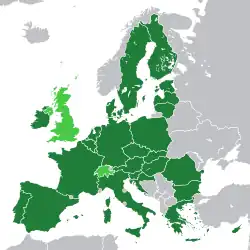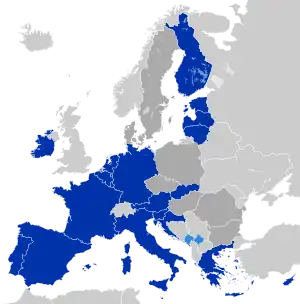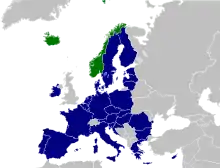| This article is part of a series on |
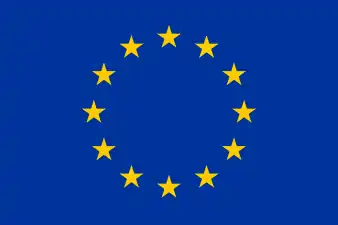 |
|---|
|
|
Members of the European Parliament (MEPs) are elected by the population of the member states of the European Union (EU). The European Electoral Act 2002 allows member states the choice to allocate electoral subdivisions or constituencies (French: circonscriptions électorales; German: Wahlkreise; Italian: circoscrizioni elettorali; Swedish: valkretsar) for the European Parliament elections in several different ways.[1]
Most EU countries operate a single national constituency which elects MEPs for the whole country.[1] Belgium and Ireland are each subdivided into constituencies, with electoral results calculated separately in each constituency.[1] Germany, Italy and Poland are each subdivided into electoral districts, with the number of representatives determined at the national level after each election in proportion to the votes cast in each district.[1]
In Germany, political parties are entitled to present lists of candidates either at Länder or national level.
France was subdivided into 8 constituencies from 2004 until 2019. Denmark had a separate constituency for Greenland until 1985, when the autonomous territory withdrew from the EEC (later expanded to become the EU).
Currently, all constituencies use various forms of proportional representation (PR), except the single-seat German-speaking electoral college in Belgium, which uses first-past-the-post. The parliament as a whole is not PR, because seats are apportioned between member states by degressive proportionality.
List of constituencies

| Constituency | Member State | Area/Community | Seats | Seats country total | Population, 2012[2] (thousands) | Area[3] (km2) | |||
|---|---|---|---|---|---|---|---|---|---|
| At election | Current | Current | Total | Per cur. seat | Total | Per cur. seat | |||
| Austria | Austria | (Full country) | 18 | 19 | 19 | 8,430 | 444 | 83,879 | 4,415 |
| Dutch-speaking electoral college | Belgium | Flemish Community | 12 | 12 | 21 | 6,389 | 532 | 13,521 | 1,127 |
| French-speaking electoral college | French Community of Belgium | 8 | 8 | 4,663 | 583 | 16,152 | 2,019 | ||
| German-speaking electoral college | German-speaking Community of Belgium | 1 | 1 | 77 | 77 | 854 | 854 | ||
| Bulgaria | Bulgaria | (Full country) | 17 | 17 | 17 | 7,306 | 430 | 110,900 | 6,524 |
| Croatia | Croatia | (Full country) | 11 | 12 | 12 | 4,269 | 356 | 56,594 | 4,716 |
| Cyprus | Cyprus | (Full country) | 6 | 6 | 6 | 864 | 144 | 9,251 | 1,542 |
| Czech Republic | Czech Republic | (Full country) | 21 | 21 | 21 | 10,511 | 501 | 78,866 | 3,756 |
| Denmark | Denmark | (Full country) | 13 | 14 | 14 | 5,592 | 399 | 42,916 | 3,065 |
| Estonia | Estonia | (Full country) | 6 | 7 | 7 | 1,323 | 189 | 45,227 | 6,461 |
| Finland | Finland | (Full country) | 13 | 14 | 14 | 5,414 | 387 | 338,435 | 24,174 |
| France | France | (Full country) | 74 | 79 | 79 | 66,233 | 838 | 656,412 | 8,309 |
| Germany | Germany | Full country, parties can opt for separate lists in the 16 Bundesländer | 96 | 96 | 96 | 81,932 | 853 | 357,162 | 3,720 |
| Greece | Greece | (Full country) | 21 | 21 | 21 | 11,093 | 528 | 131,957 | 6,284 |
| Hungary | Hungary | (Full country) | 21 | 21 | 21 | 9,920 | 472 | 93,024 | 4,430 |
| Dublin | Ireland | Dublin and counties Dún Laoghaire–Rathdown, Fingal and South Dublin | 3 | 4 | 15 | 1,271 | 318 | 921 | 230 |
| Midlands–North-West | Counties Cavan, Donegal, Galway, Kildare, Leitrim, Longford, Louth, Mayo, Meath, Monaghan, Roscommon, Sligo and Westmeath; and the city of Galway | 4 | 4 | 1,635 | 409 | 37,282 | 9,321 | ||
| South | Counties Carlow, Clare, Cork, Kilkenny, Kerry, Laois, Limerick, Offaly, Tipperary, Waterford, Wexford and Wicklow; and the cities of Cork, Limerick and Waterford | 4 | 5 | 1,675 | 335 | 31,935 | 6,387 | ||
| North-West | Italy | Aosta Valley, Liguria, Lombardy, Piedmont | 20 | 20 | 76 | 15,807 | 790 | 57,928 | 2,896 |
| North-East | Emilia-Romagna, Friuli-Venezia Giulia, Trentino-Alto Adige/Südtirol, Veneto | 14 | 15 | 11,482 | 765 | 62,327 | 4,155 | ||
| Central | Latium, Marche, Tuscany, Umbria | 14 | 15 | 11,637 | 776 | 58,084 | 3,872 | ||
| Southern | Abruzzo, Apulia, Basilicata, Calabria, Campania, Molise | 17 | 18 | 13,975 | 776 | 73,800 | 4,100 | ||
| Islands | Sardinia, Sicily | 8 | 8 | 6,639 | 830 | 49,932 | 6,242 | ||
| Latvia | Latvia | (Full country) | 8 | 8 | 8 | 2,034 | 254 | 64,573 | 8,072 |
| Lithuania | Lithuania | (Full country) | 11 | 11 | 11 | 2,988 | 272 | 65,300 | 5,936 |
| Luxembourg | Luxembourg | (Full country) | 6 | 6 | 6 | 531 | 88 | 2,586 | 431 |
| Malta | Malta | (Full country) | 6 | 6 | 6 | 420 | 70 | 316 | 53 |
| Netherlands | Netherlands | (Full country) | 26 | 29 | 29 | 16,755 | 578 | 41,540 | 1,432 |
| Pomeranian | Poland | Pomeranian Voivodeship | 3 | 3 | 52 | 2,287 | 762 | 18,310 | 6,103 |
| Kuyavian-Pomeranian | Kuyavian-Pomeranian Voivodeship | 2 | 2 | 2,097 | 1,049 | 17,972 | 8,986 | ||
| Podlaskie and Warmian-Masurian | Podlaskie and Warmian-Masurian Voivodeships | 3 | 3 | 2,651 | 884 | 44,360 | 14,787 | ||
| Warsaw | City of Warsaw and part of the Masovian Voivodeship[note 1] | 6 | 6 | 2,795 | 466 | 11,205 | 1,868 | ||
| Masovian | The rest of the Masovian Voivodeship[note 2] | 3 | 3 | 2,499 | 833 | 24,353 | 8,118 | ||
| Łódź | Łódź Voivodeship | 3 | 3 | 2,529 | 843 | 18,219 | 6,073 | ||
| Greater Poland | Greater Poland Voivodeship | 5 | 5 | 3,350 | 670 | 15,183 | 3,037 | ||
| Lublin | Lublin Voivodeship | 3 | 3 | 2,169 | 732 | 25,122 | 8,374 | ||
| Subcarpathian | Subcarpathian Voivodeship | 3 | 3 | 2,129 | 710 | 17,846 | 5,949 | ||
| Lesser Poland and Świętokrzyskie | Lesser Poland and Świętokrzyskie Voivodeships | 5 | 6 | 4,735 | 789 | 41,537 | 6,923 | ||
| Silesian | Silesian Voivodeship | 7 | 7 | 4,621 | 660 | 12,333 | 1,762 | ||
| Lower Silesian and Opole | Lower Silesian and Opole Voivodeships | 4 | 4 | 3,928 | 982 | 29,359 | 7,340 | ||
| Lubusz and West Pomeranian | Lubusz and West Pomeranian Voivodeships | 4 | 4 | 2,745 | 686 | 36,880 | 9,220 | ||
| Portugal | Portugal | (Full country) | 21 | 21 | 21 | 10,515 | 501 | 92,212 | 4,391 |
| Romania | Romania | (Full country) | 32 | 33 | 33 | 21,385 | 648 | 238,391 | 7,224 |
| Slovakia | Slovakia | (Full country) | 13 | 14 | 14 | 5,408 | 386 | 49,036 | 3,503 |
| Slovenia | Slovenia | (Full country) | 8 | 8 | 8 | 2,057 | 257 | 20,273 | 2,534 |
| Spain | Spain | (Full country) | 54 | 59 | 59 | 46,773 | 793 | 505,991 | 8,576 |
| Sweden | Sweden | (Full country) | 20 | 21 | 21 | 9,519 | 453 | 438,576 | 20,885 |
| Total | 751 | 705 | 705 | 445,056 | 631 | 4,238,831 | 6,013 | ||
- ↑ Powiats: Grodzisk Mazowiecki, Legionowo, Nowy Dwór, Otwock, Piaseczno, Pruszków, Warsaw West and Wołomin
- ↑ Powiats: Ciechanów, Gostyń, Mława, Płock, Płońsk, Przasnysz, Sierpc, Sochaczew, Żuromin, Żyrardów, Białobrzegi, Grójec, Kozienice, Lipsko, Przysucha, Radom, Szydłowiec, Zwoleń, Garwolin, Łosice, Maków, Mińsk, Ostrołęka, Ostrów Mazowiecka, Pułtusk, Siedlce, Sokołów, Węgrów, Wyszków and the cities of Płock, Radom, Ostrołęka and Siedlce
Regional constituencies
 European Parliament constituencies in Belgium
European Parliament constituencies in Belgium
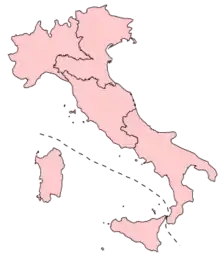 European Parliament constituencies in Italy
European Parliament constituencies in Italy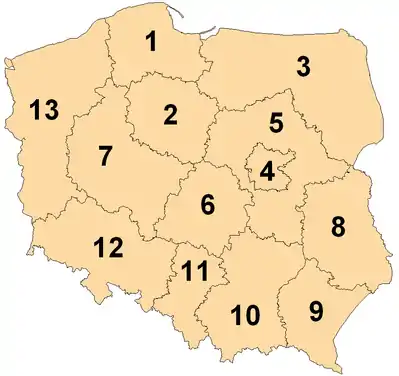
Former regional constituencies
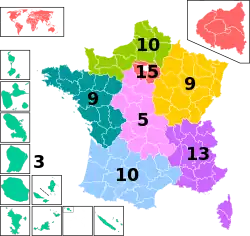 European Parliament constituencies in France (2004 to 2019)
European Parliament constituencies in France (2004 to 2019).png.webp)
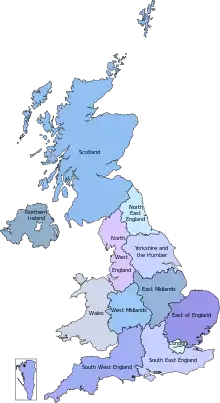
Full lists
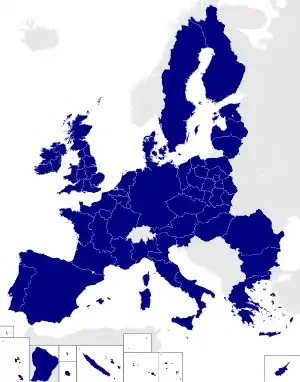
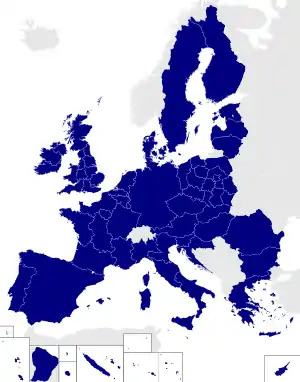
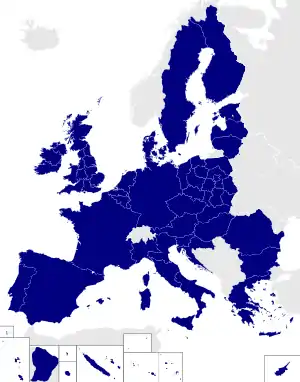

Proposed pan-European constituency
On May 3, 2022, the European Parliament passed (323 votes to 262) a "legislative resolution on the reform of European electoral law".[4] Among the proposals is the creation of a 28-member pan-Union constituency elected by party-list proportional representation on a list separate from elections for regional constituencies.[5] However in July 2023 the reference to it was removed by the European Council.[6]
See also
References
- 1 2 3 4 Oelbermann, Kai-Friederike; Palomares, Antonio; Pukelsheim, Friedrich (2010). "The 2009 European Parliament Elections: From Votes to Seats in 27 Ways" (PDF). European Electoral Studies. 5 (1): 148–182. Archived (PDF) from the original on 15 September 2013.
- ↑ Eurostat (14 March 2014). "Average annual population (1000) by NUTS 2 region". Retrieved 26 May 2014.
- ↑ Eurostat (19 May 2014). "Total area and land area by NUTS 2 region". Retrieved 26 May 2014.
- ↑ https://www.europarl.europa.eu/doceo/document/TA-9-2022-0129_EN.html See Article 15 Union-wide constituency
- ↑ Kurmayer, Nikolaus J. (3 May 2022). "European Parliament agrees position on EU election law overhaul". www.euractiv.com. Retrieved 3 May 2022.
- ↑ "European Parliament set to grow by 15 MEPs in 2024". POLITICO. 28 July 2023. Retrieved 30 August 2023.
External links
- Fact Sheets on the European Union
- European Parliament election, 2004 (Belgium) – electoral law
- European Parliament election, 2004 (Finland) – electoral law
- European Parliament election, 2004 (France) – electoral law
- European Parliament election, 2004 (Ireland) – electoral law
- European Parliament election, 2004 (Poland) – electoral law
- European Parliament election, 2004 (United Kingdom) – electoral law
